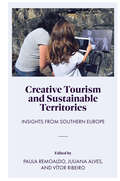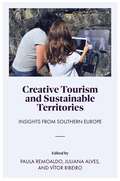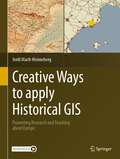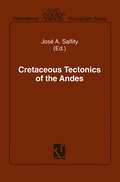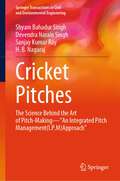- Table View
- List View
Creative Practice and Socioeconomic Crisis in the Caribbean: A path to sustainable growth
by Kent J. WessingerAlthough the world is saturated with extraordinary methods, innovation, and technology, the Caribbean seems to have been left behind in the sustainable growth of global development. While the majority of the world defines the Caribbean as "paradise," the reality of life for Afro-Caribbean culture is defined by an unrelenting hardship. This book comprehensively analyzes this phenomenon from a unique and intimate perspective in order to offer a viable pathway to sustainable growth. By examining the historic progression of the Caribbean region and the African culture within, the author explores the relationship between creative practice and socioeconomic crisis and questions whether limited access to environments that facilitate original and conceptual ideas correlates with socioeconomic crisis. The outcomes and methods of analysis developed in this book are a useful tool for other cultures or organizations seeking to diffuse socioeconomic crisis and implement a pathway of sustainable growth. This innovative book will be of great interest to students and scholars of cultural and sustainability studies, Caribbean and African Studies, as well as Development and Sustainable Development
Creative Practice and Socioeconomic Crisis in the Caribbean: A path to sustainable growth
by Kent J. WessingerAlthough the world is saturated with extraordinary methods, innovation, and technology, the Caribbean seems to have been left behind in the sustainable growth of global development. While the majority of the world defines the Caribbean as "paradise," the reality of life for Afro-Caribbean culture is defined by an unrelenting hardship. This book comprehensively analyzes this phenomenon from a unique and intimate perspective in order to offer a viable pathway to sustainable growth. By examining the historic progression of the Caribbean region and the African culture within, the author explores the relationship between creative practice and socioeconomic crisis and questions whether limited access to environments that facilitate original and conceptual ideas correlates with socioeconomic crisis. The outcomes and methods of analysis developed in this book are a useful tool for other cultures or organizations seeking to diffuse socioeconomic crisis and implement a pathway of sustainable growth. This innovative book will be of great interest to students and scholars of cultural and sustainability studies, Caribbean and African Studies, as well as Development and Sustainable Development
Creative Representations of Place (Routledge Research in Culture, Space and Identity)
by Alison BarnesCultural geography and the social sciences have seen a rise in the use of creative methods with which to understand and represent everyday life and place. Conversely, many artists are producing work that centres on ideas of place and space and utilising empirical research methods that have a resonance with geographers. This book contributes to the body of literature emerging from such creative approaches to place. Drawing together theory and practice from cultural geography, anthropology and graphic design, this book proposes an interdisciplinary geo/graphic process for interrogating and re/presenting everyday life and place. A diverse set of research projects highlights participatory and autoethnographic approaches to the research. The sites of the projects are varied, encompassing the commercial space of grocery shops, cafés and restaurants, the private, domestic space of the home, and a Scottish World Heritage site. The theoretical context of each project highlights the transferability of the geo/graphic process, with place being variously framed within discussions of food, multi-culturalism and belonging; home, collecting and meaningful possessions; and, materiality, memory and affect. Themes in the book will appeal to researchers working in the creative methods field. This book will also be essential supplementary reading for postgraduate students studying Cultural Geography, Experimental Geographies, Visual Anthropology, Art and Design.
Creative Representations of Place (Routledge Research in Culture, Space and Identity)
by Alison BarnesCultural geography and the social sciences have seen a rise in the use of creative methods with which to understand and represent everyday life and place. Conversely, many artists are producing work that centres on ideas of place and space and utilising empirical research methods that have a resonance with geographers. This book contributes to the body of literature emerging from such creative approaches to place. Drawing together theory and practice from cultural geography, anthropology and graphic design, this book proposes an interdisciplinary geo/graphic process for interrogating and re/presenting everyday life and place. A diverse set of research projects highlights participatory and autoethnographic approaches to the research. The sites of the projects are varied, encompassing the commercial space of grocery shops, cafés and restaurants, the private, domestic space of the home, and a Scottish World Heritage site. The theoretical context of each project highlights the transferability of the geo/graphic process, with place being variously framed within discussions of food, multi-culturalism and belonging; home, collecting and meaningful possessions; and, materiality, memory and affect. Themes in the book will appeal to researchers working in the creative methods field. This book will also be essential supplementary reading for postgraduate students studying Cultural Geography, Experimental Geographies, Visual Anthropology, Art and Design.
Creative Tourism and Sustainable Territories: Insights from Southern Europe
by Paula Remoaldo, Juliana AlvesCreative Tourism and Sustainable Territories: Insights from Southern Europe examines the growth and development of this emerging and fast developing area of tourism practice, while assessing it’s impacts on sustainability and regional development. Examples are drawn from across Southern Europe with analysis of Creative Tourism practices in Portugal, Italy, Spain, Greece, Croatia, Serbia, Montenegro, and Slovenia. Creative Tourism and Sustainable Territories features chapters from leading scholars that explore the definition and evolution of Creative Tourism, the roles played by urban and rural territories, the motivations and profiles of a creative tourist, best practices in Creative Tourism and contribution of festivals to Creative Tourism and territorial development providing an expansive study that will be of interest to researchers in Tourism Studies, Hospitality Studies, Sustainability, Economic Development and Cultural Industries, and Geography.
Creative Tourism and Sustainable Territories: Insights from Southern Europe
by Paula Remoaldo Juliana Alves Vítor RibeiroCreative Tourism and Sustainable Territories: Insights from Southern Europe examines the growth and development of this emerging and fast developing area of tourism practice, while assessing it’s impacts on sustainability and regional development. Examples are drawn from across Southern Europe with analysis of Creative Tourism practices in Portugal, Italy, Spain, Greece, Croatia, Serbia, Montenegro, and Slovenia. Creative Tourism and Sustainable Territories features chapters from leading scholars that explore the definition and evolution of Creative Tourism, the roles played by urban and rural territories, the motivations and profiles of a creative tourist, best practices in Creative Tourism and contribution of festivals to Creative Tourism and territorial development providing an expansive study that will be of interest to researchers in Tourism Studies, Hospitality Studies, Sustainability, Economic Development and Cultural Industries, and Geography.
Creative Ways to apply Historical GIS: Promoting Research and Teaching about Europe
by Jordi Martí-HennebergThis volume promotes the use of Historical GIS (H-GIS) for both education and research. It consists of a coherent set of chapters that allow readers to study the spatial histories of cities, infrastructure, landscapes, and more across Europe. Each chapter is accompanied by Electronic Supplementary Material (ESM) including GIS data, guides and complementary material in .pdf format, and more. To date, there are no similar materials available in this field compiled in a single book. Interdisciplinarity in spatial research is a main theme of this volume, and the text and tools provided here allow readers to combine inputs relating to the study of earth sciences, population, urban growth and transportation, focusing on changes over both space and time. Each chapter provides data in GIS format and also a user's guide to enable readers to deeply engage with the contents themselves. Guidelines are provided to help locate new data about other areas of the world, which users will be able to develop independently. The book is divided into three parts, each presenting different scales of study and analysis at the local, regional and national levels. Part One deals with general subjects analyzed across large areas, mainly within Europe. Part Two provides more specific subjects and data. Part Three covers sources and teaching with H-GIS. The book will be of interest to researchers, academics, teachers and students from secondary schools up to university level. Each subject and tutorial is aimed at a multi-level audience.
Creativity (Key Ideas in Geography)
by Harriet HawkinsCreativity, whether lauded as the oil of the 21st century, touted as a driver of international policy, or mobilised by activities, has been very much part of the zeitgeist of the last few decades. Offering the first accessible, but conceptually sophisticated account of the critical geographies of creativity, this title provides an entry point to the diverse ways in which creativity is conceptualized as a practice, promise, force, concept and rhetoric. It proffers these critical geographies as the means to engage with the relations and tensions between a range of forms of arts and cultural production, the cultural economy and vernacular, mundane and everyday creative practices. Exploring a series of sites, Creativity examines theoretical and conceptual questions around the social, economic, cultural, political and pedagogic imperatives of the geographies of creativity, using these geographies as a lens to cohere broader interdisciplinary debates. Central concepts, cutting-edge research and methodological debates are made accessible with the use of inset boxes that present key ideas, case studies and research. The text draws together interdisciplinary perspectives on creativity, enabling scholars and students within and without Geography to understand and engage with the critical geographies of creativity, their breadth and potential. The volume will prove essential reading for undergraduate and post-graduate students of creativity, cultural geography, the creative economy, cultural industries and heritage.
Creativity (Key Ideas in Geography)
by Harriet HawkinsCreativity, whether lauded as the oil of the 21st century, touted as a driver of international policy, or mobilised by activities, has been very much part of the zeitgeist of the last few decades. Offering the first accessible, but conceptually sophisticated account of the critical geographies of creativity, this title provides an entry point to the diverse ways in which creativity is conceptualized as a practice, promise, force, concept and rhetoric. It proffers these critical geographies as the means to engage with the relations and tensions between a range of forms of arts and cultural production, the cultural economy and vernacular, mundane and everyday creative practices. Exploring a series of sites, Creativity examines theoretical and conceptual questions around the social, economic, cultural, political and pedagogic imperatives of the geographies of creativity, using these geographies as a lens to cohere broader interdisciplinary debates. Central concepts, cutting-edge research and methodological debates are made accessible with the use of inset boxes that present key ideas, case studies and research. The text draws together interdisciplinary perspectives on creativity, enabling scholars and students within and without Geography to understand and engage with the critical geographies of creativity, their breadth and potential. The volume will prove essential reading for undergraduate and post-graduate students of creativity, cultural geography, the creative economy, cultural industries and heritage.
Creativity: Theories and Themes: Research, Development, and Practice
by Mark A. RuncoAn integrative introduction to the theories and themes in research on creativity, this book is both a reference work and text for courses in this burgeoning area of research. The book begins with a discussion of the theories of creativity (Person, Product, Process, Place), the general question of whether creativity is influenced by nature or nurture, what research has indicated of the personality and style of creative individuals from a personality analysis standpoint, how social context affects creativity, and then coverage of issues like gender differences, whether creativity can be enhanced, if creativity is related to poor mental or physical health, etc. The book contains boxes covering special interest items including one page biographies of famous creative individuals and activities for a group or individual to test and/or encourage creativity, as well as references to internet sites relating to creativity. Breaks down the major theories about creativity but doesn't restrict to a singular perspective Includes extensive citations of existing literature Textbook features included (i.e., key terms defined)
Creativity and Space: Labour and the Restructuring of the German Advertising Industry (Routledge Revivals)
by Joachim ThielOriginally published in 2005. By examining the changing patterns of the German advertising industry from a spatial-economic perspective, focusing on the rise of Hamburg as the country's new creative capital, this book discusses the shifting relations between economic organization, social relations and spatial structures in the post-industrial economy. It argues that it is the professional labour market which drives the organization and the spatial structure of knowledge-intensive activities. It does not, however, only imply the increasing importance of labour as a factor of production, but also suggests an increasing uncertainty linked to the nature of knowledge - labour. Illustrated by in-depth empirical material, the book brings together debates on reflexive modernization and individualization with those on embeddedness and on the role of business services in regional development. It concludes that it is the labour market of professionals which provides a regional and social anchoring of economic activities, while at the same time pointing out the increasing importance of metropolitan regions.
Creativity and Space: Labour and the Restructuring of the German Advertising Industry (Routledge Revivals)
by Joachim ThielOriginally published in 2005. By examining the changing patterns of the German advertising industry from a spatial-economic perspective, focusing on the rise of Hamburg as the country's new creative capital, this book discusses the shifting relations between economic organization, social relations and spatial structures in the post-industrial economy. It argues that it is the professional labour market which drives the organization and the spatial structure of knowledge-intensive activities. It does not, however, only imply the increasing importance of labour as a factor of production, but also suggests an increasing uncertainty linked to the nature of knowledge - labour. Illustrated by in-depth empirical material, the book brings together debates on reflexive modernization and individualization with those on embeddedness and on the role of business services in regional development. It concludes that it is the labour market of professionals which provides a regional and social anchoring of economic activities, while at the same time pointing out the increasing importance of metropolitan regions.
Creativity in Tokyo: Revitalizing a Mature City
by Matjaz Ursic Heide ImaiThis book focuses on overlooked contextual factors that constitute the urban creative climate or innovative urban milieu in contemporary cities. Filled with reflections based on interviews with a diverse range of creative actors in various local neighborhoods in Tokyo, it offers a rare glimpse into the complex set of elements that provide long-term, physical, and sociocultural support to urban creativity. Ursic and Imai highlight the interplay between physical and soft (social) factors in the process of place-making and explore how a city’s creativity is influenced by financial support and accessible infrastructure, as well as the sets of informal networks, services, and tacit, locally embedded knowledge that provide the basic layers of stimuli needed for creativity to fully develop. The authors show how the future development of creativity and the overall development of a city depend not only on the (top-down) planning strategies of formal authorities, but also on the appropriate (bottom-up) inclusion of heterogeneous elements that are provided and embedded within the small, hidden context of city spaces.
Creatures Of Habitat: The Changing Nature of Wildlife and Wild Places in Utah and the Intermountain West
by Mark HengesbaughFrom flying squirrels on high wooded plateaus to hanging gardens in redrock canyons, the Intermountain West is home to some of the world's rarest and most fascinating animals and plants. Creatures of Habitat details many unique but little-known talents of this region's strange and wonderful wild inhabitants and descibes their connections with native environments. For example, readers will learn about the pronghorn antelope's supercharged cardiovascular system, a brine shrimp-powered shorebird that each year flies nonstop from the Great Salt Lake to Central Argentina, and a rare mustard plant recently discovered on Mount Ogden. Emphasizing how increasing loss and degradation of habitat hinders native species' survival, Mark Gerard Hengesbaugh discusses what is happening to wildlife and wild places and what is being done about it. Well illustrated, this book has habitat maps, pen-and-ink illustrations, and fifty photos of wildlife and wild places selected by photo editor Dan Miller. Also included are guides to wildlife viewing and lists of Utah species, including those considered sensitive, threatened, or endangered.
Creatures of Jurisprudence: Bears and Bees as Juridical Species
by Edward MussawirTo what extent can an animal constitute a ‘juridical species’? This highly original book considers how animals have been integral to law and to legal thinking.Going beyond the traditional approaches to animal rights and the question of whether non-human animals may be considered legal ‘subjects,’ this book follows two types of animal – bears and bees – and asks what existence these species have maintained in juridical thought. Uncovering surprising roles that the animals play in the imagination of and solution to jurisprudential problems, the book offers a counter-argument to the view that juridical thought reduces one’s appreciation for the singularity and independence of their lives. It shows, rather, that the animals exert a remarkable influence on the creative dimensions of law, offering a liveliness to it that is worthy of close attention.Contributing to new directions at the intersection of jurisprudence and human–animal studies, this book will appeal to those with interests in either of these areas.
Creatures of Jurisprudence: Bears and Bees as Juridical Species
by Edward MussawirTo what extent can an animal constitute a ‘juridical species’? This highly original book considers how animals have been integral to law and to legal thinking.Going beyond the traditional approaches to animal rights and the question of whether non-human animals may be considered legal ‘subjects,’ this book follows two types of animal – bears and bees – and asks what existence these species have maintained in juridical thought. Uncovering surprising roles that the animals play in the imagination of and solution to jurisprudential problems, the book offers a counter-argument to the view that juridical thought reduces one’s appreciation for the singularity and independence of their lives. It shows, rather, that the animals exert a remarkable influence on the creative dimensions of law, offering a liveliness to it that is worthy of close attention.Contributing to new directions at the intersection of jurisprudence and human–animal studies, this book will appeal to those with interests in either of these areas.
Creep in Ceramics (Solid Mechanics and Its Applications #241)
by Joshua PellegThis book focuses on Creep in Ceramics. The book consists of two parts. In part A general knowledge of creep in ceramics is considered, while part B specifies creep in technologically important ceramics, namely creep in oxide ceramics, carnides and nitrides. While covering all relevant information regarding raw materials and characterization of creep in ceramics, the book also summarizes most recent innovations and developments in this field as a result of extensive literature search.
Creeping Bentgrass Management
by Peter H. DernoedenCreeping bentgrass is considered the premier turfgrass species grown on golf courses, and there is a growing demand for an understanding of its maintenance and management practices. Still the only comprehensive reference on the subject, Creeping Bentgrass Management, Second Edition helps you identify the factors that contribute to summer bentgrass
Cretaceous Fossils of South-Central Africa: An Illustrated Guide
by Michael Robert CooperThis book serves as an introduction to the Cretaceous geology and palaeontology of south-central Africa, covering the whole of Southern and Eastern Africa and Angola. Fifty two plates illustrate almost 1000 species and provide a field guide to the macrofossils of the subcontinent. The book will be of value to field geologists, students and non-specialists with an interest in the natural world. A bibliography of the Cretaceous palaeontology and stratigraphy of the subcontinent is provided. Features: Provides a concise account of the Cretaceous geology for 13 African regions Includes beautiful illustrations and a comprehensive bibliography Fossils are presented in stratigraphical order, allowing easy determination of the age deposits.
Cretaceous Fossils of South-Central Africa: An Illustrated Guide
by Michael Robert CooperThis book serves as an introduction to the Cretaceous geology and palaeontology of south-central Africa, covering the whole of Southern and Eastern Africa and Angola. Fifty two plates illustrate almost 1000 species and provide a field guide to the macrofossils of the subcontinent. The book will be of value to field geologists, students and non-specialists with an interest in the natural world. A bibliography of the Cretaceous palaeontology and stratigraphy of the subcontinent is provided. Features: Provides a concise account of the Cretaceous geology for 13 African regions Includes beautiful illustrations and a comprehensive bibliography Fossils are presented in stratigraphical order, allowing easy determination of the age deposits.
Cretaceous Resources, Events and Rhythms: Background and Plans for Research (Nato Science Series C: #304)
by Robert N. Ginsburg B. BeaudoinProceedings of the NATO Advanced Research Workshop, Digne, France, September 16-22, 1988
Cricket Pitches: The Science Behind the Art of Pitch-Making—“An Integrated Pitch Management (I.P.M) Approach” (Springer Transactions in Civil and Environmental Engineering)
by Shyam Bahadur Singh Devendra Narain Singh Sanjay Kumar Ray H. B. NagarajThe book develops a practical understanding of the fundamental scientific principles and logic underlying the art of turf pitch preparation, measuring, analysing, and interpreting pitch surface behaviour. It’s an attempt to understand how the captains, players, coaches, curators, and groundsmen comprehend and analyse the cricket pitch behaviour (days before and during the matches) and whether the pitch behaviour can be standardised and quantified (through bench marking or forming a data-based management system (DBMS) of a pitch profile, pitch quality standards, a pitch behaviour analysis index (PBAI), or pitch behaviour forecasting (PBF) by examining or analysing its mineralogical, chemical, physical, or morphological compositions, weather variables, and different pitch preparation methods and techniques. Individual chapters in this book deal with clay mineralogy, the bench-marking of cricket pitch soils, pitch soil chemical properties, pitch soil water, pitch turf grass, pitch soil organic matter, integrated rolling management, soil structure, and compressibility. This is an effort to decipher the impact of each and every major and minor component of pitch soil, which controls the pitch behaviour either in large or small magnitudes but acts as a critical factor in defining and shaping the pitch behaviour as a whole. Several real-life examples, pitch interviews, scenarios, and case studies as felt and observed by the curator( first author) during the preparation of various international, national, and board matches or during the construction and renovation of new wickets have been included in each and every relevant chapter so as to analyse, interpret, comprehend, and justify the theoretical science with the existing practises involved in pitch construction, preparation, or judging the complex nature of pitch behaviour. Based on findings through the DBMS, PBAI, and PQS of cricket pitch profiles, various innovative and simple methods of analysing, comprehending, and forecasting pitch behaviour have been devised that will enable one to judge and comprehend the complex pitch behaviour in simple ways.
Crime Mapping Case Studies: Practice and Research
by Spencer Chainey Lisa TompsonCrime Mapping Case Studies: From Research to Practice provides a series of key examples from practice and research that demonstrate applications of crime mapping and its effect in many areas of policing and crime reduction. This book brings together case studies that show how crime mapping can be used for analysis, intelligence development, monitoring performance, and crime detection and is written by practitioners for practitioners. Leading researchers in the field describe how crime mapping is developing and exposing analytical methodologies and critiquing current practices. Including global case studies that demonstrate a particular application, analytical technique or new theoretical concept, this text offers a truly global overview of this rapidly growing area of interest. Unlike other texts on this topic, this book identifies mistakes and challenges in this field of enquiry to aid the reader in understanding the basics of this technique, giving them the opportunity to learn further.
Crime Modeling and Mapping Using Geospatial Technologies (Geotechnologies and the Environment #8)
by Michael LeitnerRecent years in North America have seen a rapid development in the area of crime analysis and mapping using Geographic Information Systems (GIS) technology. In 1996, the US National Institute of Justice (NIJ) established the crime mapping research center (CMRC), to promote research, evaluation, development, and dissemination of GIS technology. The long-term goal is to develop a fully functional Crime Analysis System (CAS) with standardized data collection and reporting mechanisms, tools for spatial and temporal analysis, visualization of data and much more. Among the drawbacks of current crime analysis systems is their lack of tools for spatial analysis. For this reason, spatial analysts should research which current analysis techniques (or variations of such techniques) that have been already successfully applied to other areas (e.g., epidemiology, location-allocation analysis, etc.) can also be employed to the spatial analysis of crime data. This book presents a few of those cases.


